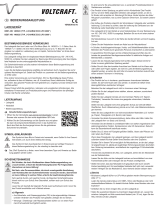Page is loading ...

Safety Notes
Read the operating instructions attentively and particularly observe the safety
notes. If the safety notes and the information in these operating instructions
regarding proper handling are not observed, we assume no liability for any
resulting injury/property damage. In such cases, the warranty/guarantee will
also lapse.
a) General
• Theunauthorizedconversionand/ormodicationoftheproductisinadmissible
becauseofsafetyandapprovalreasons.Neverdismantletheproduct!
• Maintenance,adjustment,orrepairworkmustonlybecarriedoutbyaspecialist/a
specialistworkshop.Thedevicecontainsnopartsthatrequireservicingoradjust-
ingbyyou.
• Theproductisnotatoyandmustbekeptoutofreachofchildren!
Theproductmustonlybesetup,usedorstoredinplacesthatarenotaccessible
tochildren.Thesameappliesforrechargeablebatteries.
Payparticularattentionwhenchildrenarepresent!Childrenmaychangetheset-
tingsorshort-circuittherechargeablebattery/batteries,whichmayleadtoreor
explosion.Dangertolife!
• Inschools,trainingcentres,hobbyandself-helpworkshops,theuseoftheproduct
mustbesupervisedbyresponsibletrainedpersonnel.
• Incommercialinstitutions,theaccidentpreventionregulationsoftheEmployer’s
LiabilityInsuranceAssociationforElectricalSystemsandOperatingMaterialsare
tobeobserved.
• Donotleavepackagingmateriallyingaroundcarelessly.Itmaybecomeadanger-
oustoyforchildren!
• Handletheproductwithcare;impacts,shockorfallevenfromlowheightswill
damageit.
• Ifyouarenotsureaboutthecorrect operation or if questionsarisewhichare
notcoveredbytheoperatinginstructions,pleasedonothesitatetocontactusor
anotherspecialist.
b) Mains cable/mains voltage
• ProductsetupcorrespondstoprotectionclassI.Itmustonlybeconnectedtoa
properprotectivecontactmainssocket.Observethatthehousingormainsline
insulationisnotdamagedordestroyed.
• Themainssockettowhichthe plug-inmainsunitisconnectedmustbeeasily
accessible.
• Donotpullthemainsplugfromthemainssocketbypullingthecable.
• Ifthemainscableorchargeraredamaged,donottouchit.Dangertolifefrom
electricshock!
Firstswitchoffthemainsvoltageforthemainssockettowhichthemainscable
isconnected(switchoffthecorrespondingcircuitbreakerortakeoutthefuse,
thenswitchoffthefaultinterrupterprotectionswitch(FIcircuitbreaker)sothatthe
mainssocketisseparatedfromthemainsvoltageonallpoles).
Onlythenunplugthemainsunitfromthemainssocket.
Ifthechargerisdamaged,stopoperatingit.Takeittoaspecialisedworkshopor
disposeofitinanenvironmentallyfriendlyway.
Ifthemainscableisdamaged,disposeofthedamagedmainscableinanenvi-
ronmentallycompatibleway.Donotuseitanymore.Replaceitwithanewmains
cableofthesamespecications.
c) Location for Installation
• Thechargerisintendedfordryindooruseonly.Itmustnotbecomedamporwet.
Neversetitupnearabathtub,showerorsimilar!
Ifthechargerisoperatedviathemainscable,thereisdangertolifefromelectric
shockincaseofmoisture/wetnessonthecharger/mainscable!
• Avoiddirectsunirradiation,strongheatorcold.Keepthechargerawayfromdust
anddirt.Thesameappliestoanyrechargeablebatterythatmaybeconnected.
• Donotoperatethechargerinsideofroomsorinbadambientconditionswhere
ammablegases,vapoursorexplosivedustmaybeorarepresent!Thereisa
dangerofexplosion!
• Chooseasolid,at,cleanandsufcientlylargesurfaceforthecharger.Never
placethechargeronaammablesurface(e.g.carpet,tablecloth).Alwaysusea
suitable,non-ammable,heatproofsurface.
• Keepthechargerawayfromammableoreasilyinammablematerials(e.g.cur-
tains).
• Nevercovertheventilationslits.Thereisadangerofoverheatingorre.Never
pushanyobjectsintotheventilationslotsofthecharger;Thereisadangertolife
fromelectricshock!Neverimpairthefunctionoftheintegratedfan.
• Donotplacethechargeronanyvaluablefurnituresurfaceswithoutusingasuit-
ableprotection.Otherwise,scratches,pressurepointsordiscolourationsarepos-
sible.Thesameappliestotherechargeablebattery.
• Donotusethechargerinsideavehicle.
• Thechargermustonlybesetup,usedorstoredinplacesthatarenotaccessible
tochildren.Childrenmaychangethesettingsorshort-circuittherechargeable
battery/batterypack,whichcanleadtoanexplosion.Dangertolife!
Important Informations
Multifunctional charger “V-Charge 300 Triple”
Item no. 1528380
YoucanndthemainoperatinginstructionsontheCDprovided;itisavailablethere
inPDFformat.ToopenthePDF,youneedasuitableprogramme,e.g.“Acrobat
Reader”,whichyoucandownloadfreeofchargefromwww.adobe.com.
Intended Use
Thecharger“V-Charge300Triple”hasthreeindependentcharge/dischargechannelsthateach
haveatwo-linelitdisplayandfouroperatingbuttons.
ThechargerisusedtochargeanddischargerechargeablebatteriesofthetypeNiMH/NiCd
(1-15cells),LiPo/LiIon/LiFe/LiHV(1-6cells)andleadbatteries(1-10cells,2V-20V).
Thechargingcurrentforchannel1canbesetbetween0.1Aand20.0A.Thechargingcurrent
forchannels2and3canbesetbetween0.1Aand10.0A(eachdependingonthecellnumber/
rechargeablebatteryvoltage).Themaximumtotalchargingoutputis300W(forpossiblecom-
binationofthe3chargingchannels,seechapter“TechnicalData”).
Thedischargingcurrentforchannel1canbesetbetween0.1Aand8.0A.Thedischarging
currentforchannels2and3canbesetbetween0.1Aand5.0A(dependingonthecellnumber/
rechargeablebatteryvoltage).Themaximumdischargeoutputforchannel1is25W;thatfor
channels2and3is10Weach.
Foreachofthethreecharge/dischargechannels,thereisaconnectionforatemperaturesen-
soravailableforbatterymonitoring(notenclosed,canbeorderedasanaccessory).
Formulti-celllithiumrechargeablebatteries,eachcharge/dischargechannelhasaseparate
balancer.Matchingbalancerboardsareincludedinthedelivery.
The charger has an integrated mains unit to permit operation on mains voltage (100 -
240V/AC,50/60Hz).Thechargermay,however,alsobealternativelyoperatedonastabilised
directvoltageof11-18V/DC(e.g.viaanexternalvehicleleadbatteryorasuitablemains
adapter).
Thesafetynotesandallotherinformationintheseoperatinginstructionsalwayshavetobe
observed!
Readtheoperatinginstructionscarefullyandattentively,andkeepthemforlaterreference.
Onlypasstheproductontoanythirdpartiestogetherwiththeoperatinginstructions.
Useotherthanthatdescribedabovecanleadtodamagetotheproductandmayinvolvead-
ditionalriskssuchas,forexample,shortcircuits,re,electricalshocketc.Theentireproduct
mustnotbemodiedorconverted,andthecasingmustnotbeopened!
ThisproductcomplieswiththestatutorynationalandEuropeanrequirements.
Scope of Delivery
• Multifunctionalcharger
• 3xbalancerboard
• Mainscable
• CDwithoperatinginstructions
Current operating instructions
Downloadthecurrentoperatinginstructionsviathelinkwww.conrad.com/downloadsorscan
theQRcodedisplayed.Observetheinstructionsonthewebsite.
Explanation of Symbols
Thesymbolwithalightningboltinatriangleisusedwherethereisahealthhazard,
e.g.fromelectricshock.
Theexclamation markin a triangle indicates important notes inthese operating
instructionsthatmustbeobservedstrictly.
Theproductisintendedforuseindryindoorroomsonly;itmustnotbecomedamp
orwet.
Observetheoperatinginstructions.

• Avoidsetupindirectproximityofstrongmagneticorelectromagneticelds,trans-
mitteraerialsorHFgenerators.Thiscanaffectthecontrolelectronics.
• Ensurethatthecablesarenotcrushedordamagedbysharpedges.Neverplace
anyobjectsonthecables.
• Donotplaceanycontainerslledwithliquid,vasesorplants,onornexttothe
charger/mainscable.
Whentheseliquidsgetintothecharger(ortheplugconnectionsofthemainsca-
ble),thechargerwillbedestroyedandthereisamostseveredangerofpotentially
fatalelectricshockorre.
Ifthechargerisoperatedviathemainscable,rstswitchoffthemainsvoltage
forthemainssockettowhichthemainscableisconnected(switchoffthecor-
respondingcircuitbreakerortakeoutthefuse,thenswitchoffthefaultinterrupter
protectionswitch(FIcircuitbreaker)sothatthemainssocketisseparatedfromthe
mainsvoltageonallpoles).Onlythenunplugthemainsplugofthemainscable
fromthemainssocket.
IfthechargerisoperatedviatheDCinput(11-18V/DC),disconnectthecharger
fromthevoltage/powersupply.
Thendisconnecttheconnectedrechargeablebatteryfromthecharger.Donotuse
thechargeragain-bringittoaspecialistworkshop.
d) Operation
• Thechargermaybeoperatedeitherviathemainsvoltage(230V/AC,50/60Hz)
orviaastabiliseddirectvoltageof11-18V/DC(e.g.viaanexternalvehiclelead
batteryorasuitablemainsadapter).
Useonlyoneofthetwoconnectiontypes,butneverbothatonce.Thismaydam-
agethecharger.
• Donot wear any metal orconductive materials, suchas jewellery(necklaces,
bracelets,rings,etc.)whileyouareworkingwiththechargerorbatteries.Ashort-
circuitattherechargeablebatteryorchargingcableposesadangerofburnsand
explosion.
• Donotoperatetheproductunattended.Despiteaconsiderablenumberofprotec-
tivecircuits,itisimpossibletoexcludethepossibilityofmalfunctionsorproblems
duringthechargingprocess.
• Ensurethatthereis sufcient ventilationduringoperation.Never cover upthe
charger.Leaveenoughofadistance(atleast20cm)betweenchargerandother
objects.Overheatingcausesadangerofre!
• Thechargermustonlybeusedtocharge(ordischarge)rechargeablebatteries
oftypesNiMH,NiCd,LiIon/LiPo/LiFe/LiHVandleadbatteries.Neverchargeany
otherrechargeablebatterytypes or non-rechargeable batteries.There isgreat
dangerofreorexplosion!
• Alwaysconnectthechargingcabletothechargerrst.Onlythenmustthere-
chargeablebatterybeconnectedtothechargingcable.
Whendisconnecting,proceedinreverseorder-rstdisconnecttherechargeable
batteryfromthechargingcable,thenthechargingcablefromthecharger.
Iftheorderischosenincorrectly,theremaybeashort-circuitofthechargerplugs;
thereisadangerofreandexplosion!
• Neverconnectseveralchargestoeachother.
• Thecharger hasthree chargingchannels thatare independentof eachother,
so that up to three rechargeable batteries/rechargeable battery packs can be
charged(ordischarged)atonce.However,onlyconnectasinglerechargeable
battery/rechargeablebatterypacktoeachofthethreechargingchannels.Never
connectthechargingchannelstoeachother!
• Onlyoperatetheproductinmoderateclimate,neverintropicalclimate.Formore
informationonacceptableenvironmentalconditions,seethechapter“Technical
Data”.
• Neveroperatethedeviceimmediatelyafteritwastakenfromacoldroomtoa
warmroom.Theresultingcondensationmayleadtomalfunctionsordamage!
Lettheproductreachroomtemperaturebeforetakingitintooperationagain.This
maytakeseveralhours!
• Avoidoperationindirectproximityofstrongmagneticorelectromagneticelds,
transmitteraerialsorHFgenerators.Thiscanaffectthecontrolelectronics.
• Ifyouhavereasontobelievethatthedevicecannolongerbeoperatedsafely,
disconnectitimmediatelyandmakesureitisnotoperatedunintentionally.
Disconnectthechargerfromthevoltage/currentsupply.Donotusetheproduct
anymoreafterthis,buttakeittoaspecialisedworkshopordisposeofitinan
environmentallycompatiblemanner.
• Itcanbeassumedthatoperationwithoutdangerisnolongerpossibleifthedevice
hasanyvisibledamage,thedevicenolongerworks,afterextendedstorageunder
unsuitableconditionsorafterdifculttransportconditions.
• Keeptheentireproductatadry,cool,cleansitethatisnotaccessibletochildren.
Rechargeable Battery Notes
Although use of rechargeable batteries in everyday life is a matter of course
today, there are many dangers and problems. In particular, with LiPo/LiIon/
LiFe/LiHV rechargeable batteries with their high energy content (in compari-
son with conventional NiCd or NiMH rechargeable batteries), various regula-
tions must be observed in order to avoid the danger of explosion and re.
For this reason, always ensure that you have read and understood the follow-
ing information and safety information when handling rechargeable batteries.
If the manufacturer of the rechargeable battery has provided any other infor-
mation, read it carefully and observe it!
a) General
• Rechargeablebatteriesarenotoys.Alwayskeepbatteries/rechargeablebatteries
outofthereachofchildren.
• Donotleaverechargeablebatterieslyingaroundopenly.Childrenorpetsmay
swallowthem.Ifswallowed,consultadoctorimmediately!
• Rechargeablebatteriesmustnotbeshort-circuited,takenapartorthrownintore.
Thereisariskofreandexplosion!
• Leakingordamagedbatteries/rechargeablebatteriescancausechemicalburns
toskinwhentouchedwithouttheuseofadequateprotectivegloves.
• Neverrechargenormal(non-rechargeable)batteries.Thereisariskofreand
explosion!
Non-rechargeablebatteriesaremeanttobeusedonceonlyandmustbedisposed
ofproperlywhenempty.
Onlychargerechargeablebatteriesintendedforthispurpose.Useasuitablebat-
terycharger.
• Batteriesmustnotgetdamporwet.
• Placethechargerandbatteryonanon-ammable,heat-resistantsurface(e.g.
stone tiles). Maintain enoughdistance from ammable objects. Leave enough
distancebetweenthechargerandtherechargeablebattery-neverplacethere-
chargeablebatteryonthecharger.
• Asboththechargerandthebatteryheatupduringthecharge/dischargeproce-
dure,itisnecessarytoensuresufcientventilation.Nevercoverthechargeror
therechargeablebattery!
• Neverusebatterypacksmadeupofdifferentcells.
• Neverleavethecharging/dischargingbatteriesunattended.
• Neverrechargeabatterydirectlyinthemodel.Alwaysremovetherechargeable
batteryfromthemodelforrecharging.
• Always observe correct polarity (plus/+ and minus/-) when connecting the re-
chargeablebatterytoyourmodelorcharger.Connectingthebatteryincorrectly
willnotonlydamagethemodelbutalsotherechargeablebattery.Thereisarisk
ofreandexplosion!
Thischargerhasamechanismthatprotectsagainstconnectingthepolesincor-
rectly.Nonetheless,itispossiblethatanincorrectlyconnectedbatterymayleadto
damageincertainsituations.
• Thecharger hasthree chargingchannels thatare independentof eachother,
so that up to three rechargeable batteries/rechargeable battery packs can be
charged(ordischarged)atonce.However,onlyconnectasinglerechargeable
battery/rechargeablebatterypacktoeachofthethreechargingchannels.Never
connectthechargingchannelstoeachother!
• Iftheproductisnottobeusedforanextendedperiodoftime(e.g.storage),dis-
connectanyconnectedrechargeablebatteryfromthechargeranddisconnectthe
chargerfromthevoltage/currentsupply.
Thechargerhasnomainsswitch.Ifyouoperatethechargerviathemainscable,
pullthemainsplugfromthesocketwhenyounolongerneedthecharger.
• Donotcharge/dischargeanybatterythatisstillhot(e.g.causedbyhighdischarg-
ingcurrentfromthemodel).Allowtherechargeablebatterytocooldowntoroom
temperaturebeforeattemptingtochargeordischargeit.
• Neverdamagetheexteriorcoverofabattery.Thereisariskofreandexplosion!
• Nevercharge/dischargedamaged,leakingordeformedbatteries.Thiscanresult
inareorexplosion!Disposeofanyunusablerechargeablebatteriesinanenvi-
ronmentallycompatiblefashion.Donotcontinuetousethem.
• Removethebatteryfromthechargerwhenitisfullycharged.
• Rechargetherechargeablebatteriesaboutevery3months.Otherwise,so-called
deepdischargemayresult,renderingtherechargeablebatteriesuseless.
• Keeprechargeablebatteriesinasuitablelocation.Useasmokedetectorinthe
room.Therisk of re(or the occurrenceof toxic smoke)cannot beexcluded.
Specialrechargeablebatteriesforthemodelconstructionareaaresubjecttogreat
stress(e.g.highcharginganddischargingcurrents,vibrations,etc.).

ThisisapublicationbyConradElectronicSE,Klaus-Conrad-Str.1,D-92240Hirschau(www.conrad.com).
Allrightsincludingtranslationreserved.Reproductionbyanymethod,e.g.photocopy,microlming,orthecapturein
electronicdataprocessingsystemsrequirethepriorwrittenapprovalbytheeditor.Reprinting,alsoinpart,isprohibited.
Thispublicationrepresentthetechnicalstatusatthetimeofprinting.
Copyright2017byConradElectronicSE. *1528380_V2_0417_02_VTP_m_short_EN
b) Additional Information about Lithium Batteries
Modernbatterieswithlithiumtechnologydonotonlyhaveaclearlyhighercapacity
thanNiMHorNiCdrechargeablebatterypacksbuttheyalsohaveaconsiderably
lowerweight.Thismakesthistypeofrechargeablebatteryveryinterestingforap-
plicationinmodelconstruction;so-calledLiPobatteries(lithium-polymer)areoften
usedhere.
Rechargeablelithiumbatteriesrequirespecialcarewhencharging/discharging,as
wellasduringoperationandhandling.
Forthisreason,wewouldliketoprovideyouwithsomeinformationinthesections
belowaboutthedangersandhowyoucanavoidthem,thushelpingsuchbatteries
tomaintaintheirperformanceforanextendedperiodoftimetocome.
• Theoutershellofmanyrechargeablelithiumbatteriesisonlymadeofathickfoil
andthereforeverysensitive.
Neverdestroyordamagethebattery,neverletthebatteryfallanddonotpierce
thebatterywithanyobjects!Avoidanymechanicalstrainonthebattery;neverpull
theconnectioncablesofthebattery!Thereisariskofreandexplosion!
Theseguidelines must alsobeobserved whenthebattery is insertedinto the
modelorwhenitisremovedfromthemodel.
• Ensurethatthebatterydoesnotoverheatduringusage,recharging,discharging,
transportorstorage.Donotplacethebatterynexttosourcesofheat(e.g.speed
controller,motor),keepthebatteryawayfromdirectsunlight.Thereisariskofre
andexplosionifthebatteryoverheats!
Thebatterymust never heatuptomore than +60°C(observeany additional
informationfromthemanufacturer!).
• Ifthebatteryisdamaged(e.g.afterthecrashofanaircraftorhelicoptermodel)or
theexteriorcoverissoaked/hasexpanded,donotusethebattery.Donotcharge
itanymore.Thereisariskofreandexplosion!
Handlethebatterywithcare,usesuitableprotectivegloves.Disposeofthere-
chargeablebatteryenvironmentallycompatibly.
Neverkeepsuchrechargeablebatteriesinanapartmentorahouse/garageany-
more.Damagedorbloatedlithiumrechargeablebatteriesmaycatchresuddenly.
• Onlyuseasuitablechargertochargelithiumbatteriesorusethecorrectcharging
procedure.Duetoariskofreandexplosion,conventionalchargersforNiCd,
NiMHandleadbatteriesmustnotbeused!
Alwayschoosetherightchargingproceduredependingonrechargeablebattery.
• Whenchargingalithiumbatterywithmorethanonecell,alwaysuseaso-called
balancer(oneisalreadyintegratedintothesuppliedcharger).
• ChargeLiPobatterieswithamax.chargingcurrentof1C(ifnotindicatedoth-
erwisebythebatterymanufacturer!).Thismeansthatthechargingcurrentmay
not exceed the capacity value imprinted on the battery (e.g. battery capacity
1000mAh,max.chargingcurrent1000mA=1A).
WithLiFe,LiIonandLiHVbatteries,youmustobservetheinstructionsofthebat-
terymanufacturer.
• Thedischargingcurrentmustnotexceedthevalueprintedonthebattery.
Forexample,ifavalueof“20C”isprintedonaLiPobattery,themax.discharging
currentis20timesthebattery'scapacity(e.g.batterycapacity1000mAh,max.
dischargingcurrent20C=20x1000mA=20A).
Otherwise,thebatterywilloverheat,causingdeformation/bloatingofthebattery
orexplosionandre!
Theprintedvalue(e.g“20C”)doesnotgenerallyrefertotheconstantcurrent,but
tothemaximumcurrentthatthebatteryiscapableofproducingintheshort-term.
Theconstantcurrentthereforeshouldnotbehigherthanonehalfofthegiven
value.
• Observethatthe individual cells ofalithiumrechargeablebatterymustnotbe
deep-discharged.Adeepdischargeofalithiumrechargeablebatterywillleadto
permanentdamage/destructionoftherechargeablebattery.
If the model does not provideprotection against total discharge or possess a
visualdisplayindicatingalowbattery,remembertoswitchoffthemodelintime.
Disposal
a) Product
Electronicdevicesarerecyclableandshouldnotbedisposedofinhouseholdwaste.
Disposeoftheproductaccordingtotheapplicablestatutoryprovisionsattheendof
itsservicelife.
b) Batteries/Rechargeable Batteries
Youastheenduserarerequiredbylaw(BatteryOrdinance)toreturnallusedbatteries/re-
chargeablebatteries.Disposingoftheminthehouseholdwasteisprohibited.
Batteries/rechargeable batteries that contain hazardous substances are labelled
withtheadjacenticontoindicatethatdisposalindomesticwasteisforbidden.The
descriptionsfortherespectiveheavymetalsare:Cd=cadmium,Hg=mercury,
Pb=lead(thenamesareindicatedonthebattery/rechargeablebatterye.g.below
therubbishbinsymbolshownontheleft).
Youmayreturnusedbatteries/rechargeablebatteriesfreeofchargeattheofcialcollection
pointsinyourcommunity,inourstores,orwhereverbatteries/rechargeablebatteriesaresold.
Youthusfullyourstatutoryobligationsandcontributetotheprotectionoftheenvironment.
Technical Data
Operatingvoltage............................Mainsvoltageinput:100-240V/AC,50/60Hz
.........................................................Directvoltageinput:11-18V/DC
Neverusebothinputsatthesametime.Thismaydamagethecharger.Lossof
guarantee/warranty!
Charging/dischargingchannels.......3
Chargecurrentchannel1................0.1-20.0A(dependingonthecellnumberand
rechargeablebatterytype)
Chargecurrentchannel2&3..........0.1-10.0A(dependingonthecellnumberand
rechargeablebatterytype)
Chargingoutput...............................Chargingchannel1,2and3:totalmax.300W
Chargingchannel1:max.300W
Chargingchannel2and3:max.100Weach
Chargingchannel1and2:totalmax.300W
Chargingchannel1and3:totalmax.300W
Dischargecurrentchannel1............0.1-8.0A(dependingonthecellnumberand
rechargeablebatterytype)
Dischargecurrentchannel2&3.....0.1-5.0A(dependingonthecellnumberand
rechargeablebatterytype)
Dischargeoutputchannel1.............max.25W
Dischargeoutputchannel2&3......max.10Weach
Suitablerechargeablebatteries.......NiMH/NiCd,1-15cells
LiPo/LiIon/LiFe/LiHV,1-6cells
Pb,1-10cells(ratedvoltage2-20V)
Dischargecurrentforbalancer........Channel1:500mApercell
Channel2&3:300mApercell
Delta-U-recognition..........................yes(forNiMH/NiCd,adjustable)
Maintenancechargecurrent............yes(forNiMH/NiCd,adjustable50-300mA,canbe
switchedoff)
Safetytimer.....................................yes(canbeswitchedoff)
Rechargeablebatterymemory........10
Fansintegrated................................yes
Ambientconditions..........................Temperature0°Cto+40°C;humidity0%to90%
relative,non-condensing
Weight.............................................approx.2.42kg
Dimensions......................................255x185x84mm(WxDxH)
/
